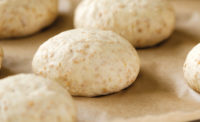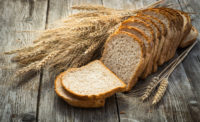Consumers are weary of words like “chlorinated,” “bleached” and “aluminum” on ingredient labels. While every baker is saying “But we’ve used these for ages!” this reason doesn’t sit well with consumer groups and buyers like Whole Foods. Sad to say, chlorinated flour has to go the way of brominated flour. It would probably not be taken off the FDA’s list of approved food ingredients, but it will be completely avoided by consumers and foodservice customers.
When you take away chlorinated flour, the results aren’t very pretty. With high-ratio cake systems, the chlorination of flour provides altered starch molecules that allow for greater absorption. This strengthens the batter to carry the heavy sugar load, which results in higher volume, finer grain and a tenderized texture.
Think twice about what you’re doing to this high-ratio cake. With that much sugar and oil, there is no way the starch, when using non-chlorinated flour, can naturally provide a proper structure for the cake—hence, the collapse.
Thre are currently a few ways to replace chlorinated flour. Heat-treated flours, or turbo milled and pre-gelatinized wheat, or other starches can help you with this replacement. It would not be a 1:1 replacement, so you have to try a few different sources and a mix of pre-gelatinized starches and hydrocolloids to come up with something satisfactory.
What next? I see aluminum as the next possible target. Why? Because consumers are afraid that aluminum can possibly be linked to Alzheimer’s disease. The difficult part about replacing sodium aluminum phosphate (SALP) is that it is very unique in its reaction rates. It’s in the Goldilocks zone—where it’s not too fast and not too slow to react. Very few other leavening acids react this way.
“The common tools available to replace SALP do not provide the stability, flavor and crumb structure resiliency,” says Barbara Heidolph, an independent consultant. “Often, due to faster reactivity and less floor time, batch sizes must be reduced, leading to less efficiency on the line. Additionally, rework may pose a greater challenge leading to variation in finished product and more waste.”
However, SAPP-28 (sodium acid pyrophosphate) was used prior to the invention of SALP and is the current best initial replacement option, along with process modifications such as batch size and dough or batter temperature, notes Heidolph. “If SALP replacement is on your project list, talk to an expert to get guidance on formulation and processing conditions.”
Emulsifiers like propylene glycol monoesters (PGME), polyglycerol esters (PGE) and polysorbates are likely on their way out, as well. I know, working without these will causes tunneling and an open crumb in your cake—and a shorter shelf life—but you would have to try something that is more label-friendly like lecithin, modified wheat proteins, hydrocolloids, eggs, enzymes or a combination of these.
Preservatives like potassium sorbate and sodium propionate are also on the hit list, although it is very difficult to find replacement for these microbial preservatives. I have seen spice-based solutions out there, but none that are quite as effective as these preservatives. The best recommendation here is to make sure your cooling area in the bakery is as clean as possible with a system that filters out mold spores. Of course, if you have a solution to this part of the clean label process, please send an email support@bakerpedia.com to alert me to it.
I haven’t suggested any 1:1 replacement of any ingredient. When you replace an ingredient, you need to look at the whole process rather than restricting yourself to a “plug and play” solution. While cleaning up your label may result in a more-expensive ingredient system, it is also an opportunity to improve your process and invest in equipment that help you clean up your label. Be creative with the tools that are within your reach. While some of us might approach clean label as a limitation to our process and capability, I would challenge you to think of it as an opportunity for process and product innovation, with limitless opportunity to truly lead in this field.




